Overview of the Client’s Economic Implications
- Tommy Bennett is a 40-year-old man who has been living in a Northeastern inner city.
- When the police found him, he was living in a cardboard house below a bridge in a homeless area.
- Bennett has been living in dilapidated conditions.
- As a result, his health has been failing.
- When he was brought to the emergency room, it was suspected that he was suffering from bilateral frostbites on his toes.
- Upon diagnosis, it was discovered that Bennett would need to have a peripheral inserted central catheter (PICC) line fixed inside his body.
Bennett’s failing health could have been contributed by the housing conditions of the homeless area. For instance, the frostbites and chills he was experiencing must have been occasioned by cold conditions due to poor housing and probably, the lack of warm clothes and proper beddings.
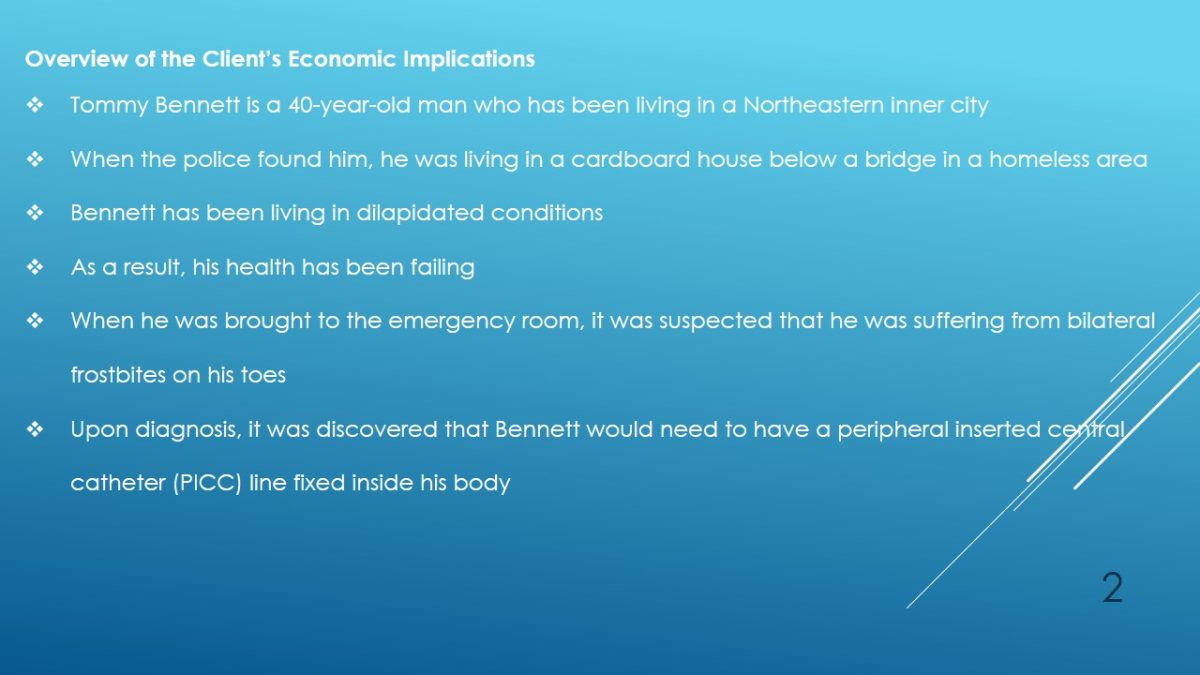
How the Client’s Economic Implications/Issues Affect Care
- The health of individuals depends on many factors, among them, access to quality care and the surrounding environment.
- The surrounding environment relates to factors such as the quality of air, water, and the condition of the housing where the individual lives.
- The socioeconomic status (SES) of an individual affects the above conditions.
- Hence, it directly influences the state of his or her health.
- Bennett has been living in a homeless area.
- The possible lack of healthcare facilities near Bennett’s residence implies that he has no immediate access to regular health checkups.
- Recent developments in the healthcare sector have resulted in high cost of care.
- Healthcare has become expensive, especially after the adoption of fee-for-service.
- The result has been that people with a low SES have limited access to quality healthcare.
- Living in a homeless area implies that Bennett is a person with a low SES.
- Besides the problem of poor diet, this status could have contributed greatly to his poor healthcare.
- At the same time, the cost of insurance for private care has increased considerably, causing many Americans to live without healthcare insurance.
- The situation encourages diseases among people such as Bennett who cannot afford quality care.
According to Chambers et al. (2014), inner cities have been found to have poorer healthcare infrastructure compared to suburban areas. Additionally, the healthcare facilities in these areas have limited equipment and poorly qualified staff (Acri et al., 2016). The net effect of these conditions is that people in inner cities have poorer health compared to their counterparts from the suburbs.
Miewald and McCann (2014) assert that poor diet among people of low SES contributes to a high disease incidence. Additionally, people living in inner cities have limited access to pure drinking water, a situation, which could contribute to a high disease incidence.
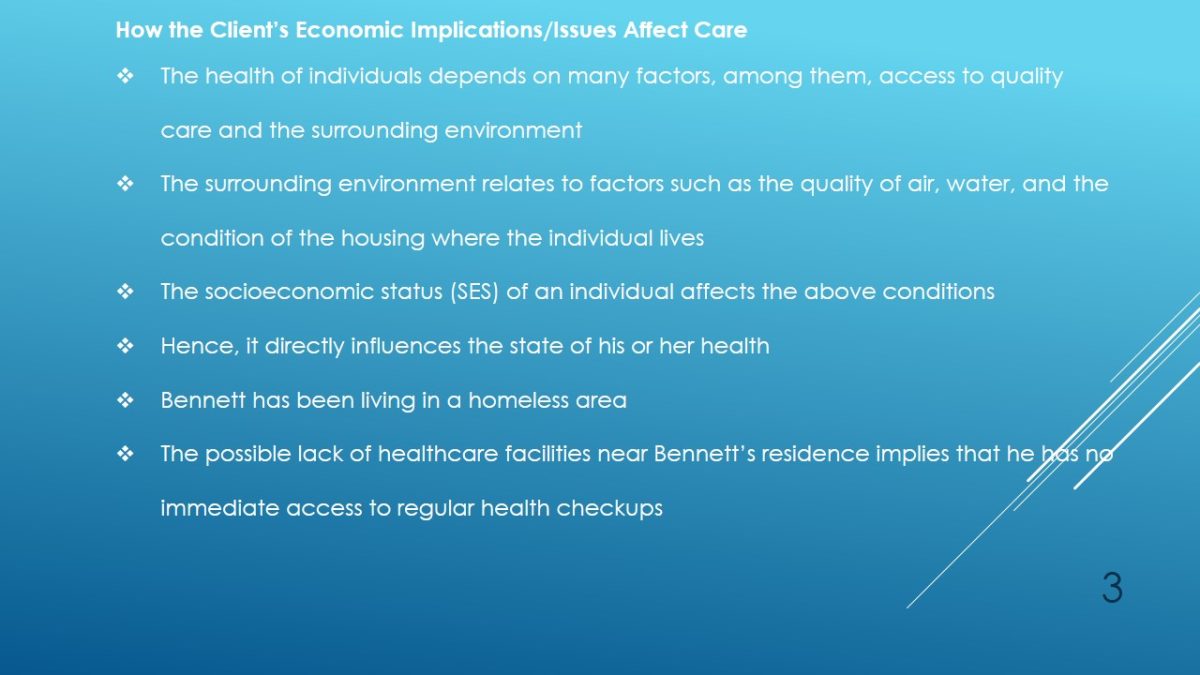
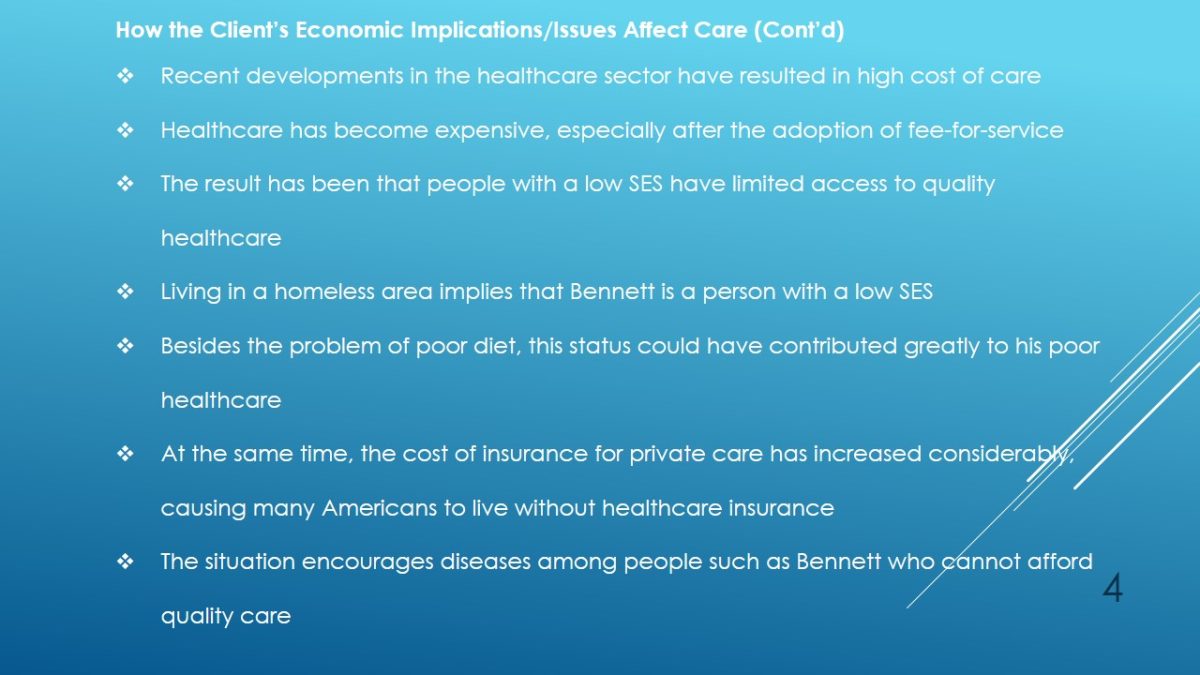
Steps that the Client should take to Manage His Health
- Patient activation involves several components among them, individual knowledge, skills, and confidence.
- Such components enable patients to be actively involved in matters regarding their health and healthcare (Greene & Hibbard, 2012).
- According to Greene and Hibbard (2012), patients with high activation levels appreciate their role in the health care process.
- They are motivated to take the necessary steps to fulfill this role.
- First, Bennett will need to take antibiotics as prescribed by the healthcare provider.
- Adherence to treatment is examined in terms of dose, the intervals between taking medication, the duration of the treatment, and other special instructions that the healthcare expert may issue.
- In the first step, Bennett may be instructed to take medication without food.
- He will need to alert the physician if he stops or alters the drug treatment regimen.
- This strategy will ensure that the physician can examine possible effects of this obstruction of the treatment.
- In the second step, Bennett will need to manage the frostbite condition by covering himself with warm clothes during cold times.
- If possible, he should leave the cardboard house.
- The goal will be to seek housing in a place with proper structures that can arrest excessive environmental cold.
- Another important step to proactive care is for Bennett to examine his lifestyle.
- This step may call for a change in diet habits while avoiding sedentary living.
- For instance, Bennett will need to increase the intake of healthy foods such as fruits and vegetables.
- At the same time, he will need to reduce the intake of unhealthy foods such as refined substances, including those that are high in sugar.
- Bennett will also need to adopt an exercise program to eliminate sedentary living.
- Exercise can facilitate blood flow in the limbs, hence reducing the effect of frostbite (Woo et al., 2013).
Patients can take various steps to manage their health with assistance from healthcare providers. The concept of involving patients to manage their own health is known as patient activation.
Leaving the cardboard house will prevent the frost-bitten area from refreezing, hence preserving the affected tissue (Woo et al., 2013).
The fitness program should be designed to begin with minimum impact exercises at first, followed by higher impact exercises. Importantly, Bennett will need to avoid unhealthy habits such as excessive drinking and smoking, as well as any other drugs that are categorized as harmful for human consumption. Drug abuse and alcoholism are associated with frostbite (Woo et al., 2013).
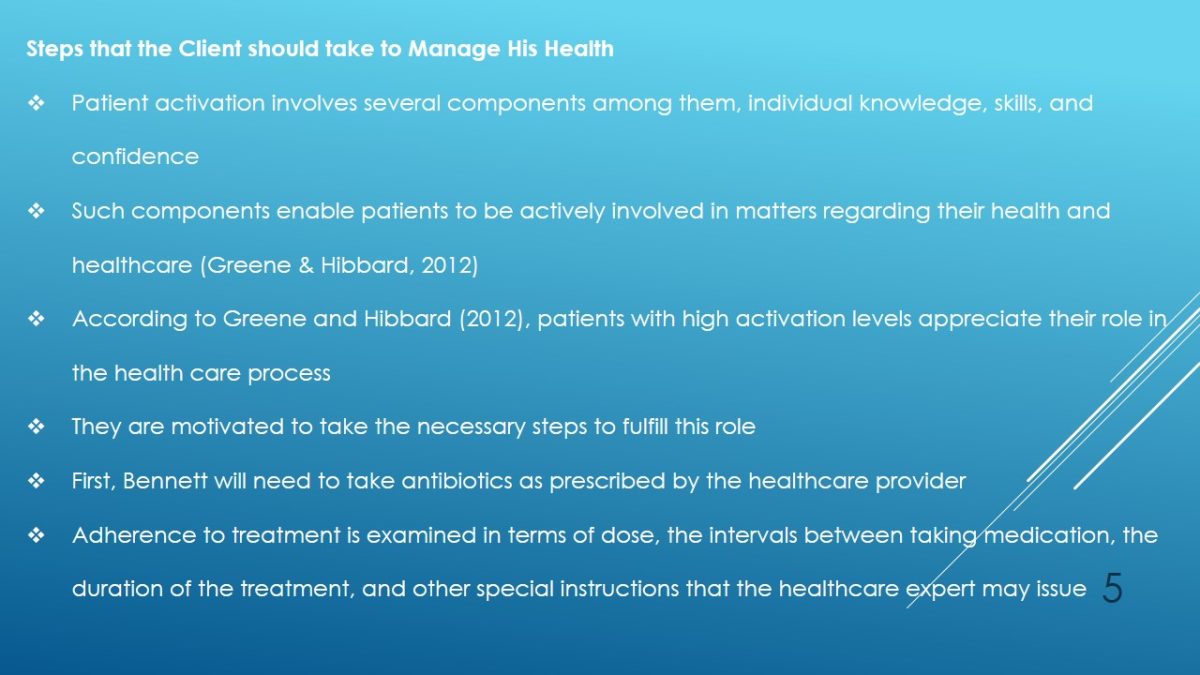
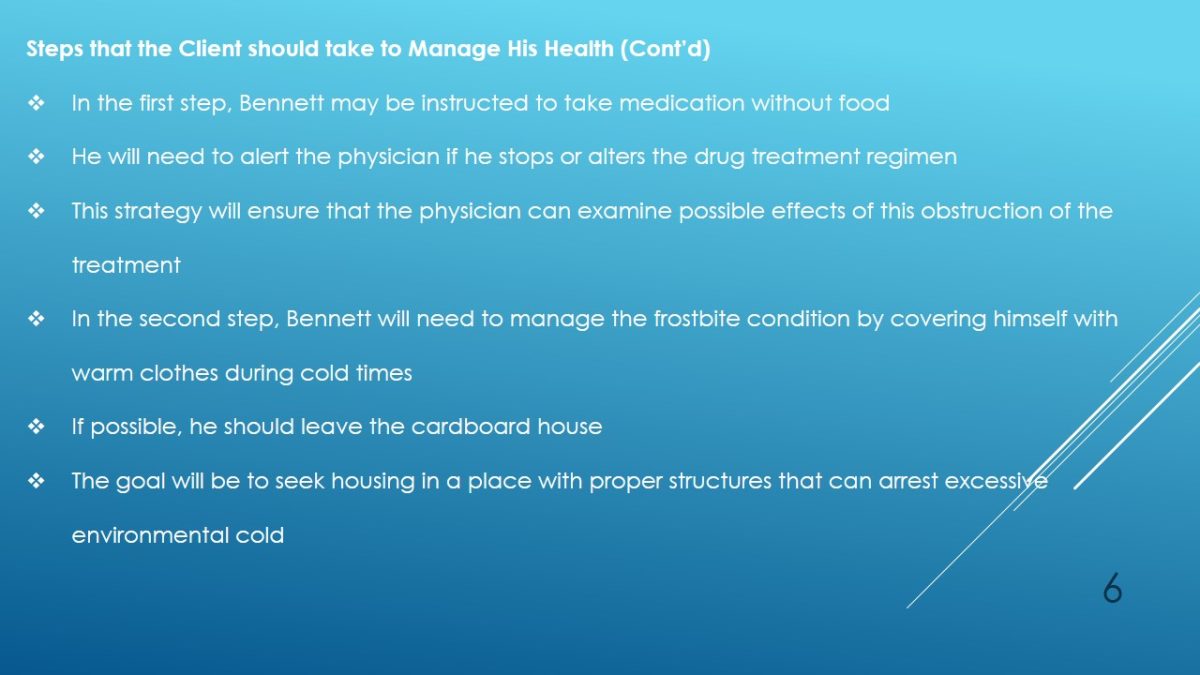
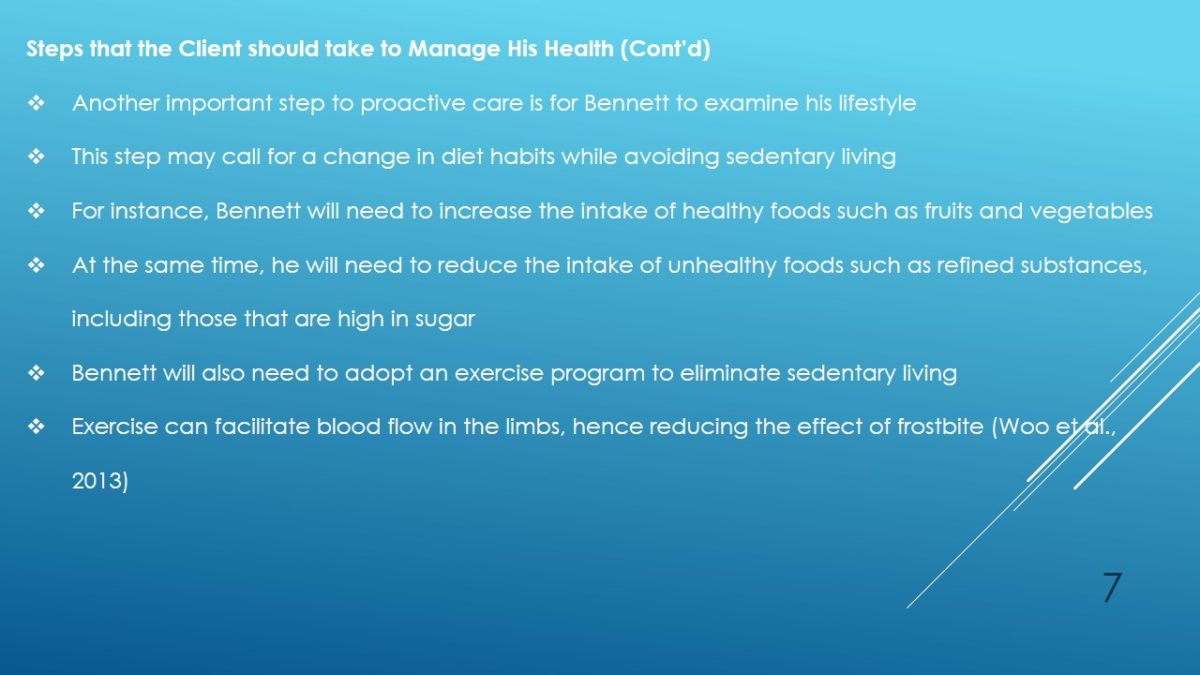
Rationale for Following the Plan
- Often, patients fail to follow instructions on how to take the medications provided to them by healthcare givers.
- This situation causes the disease to fail to heal.
- It also makes disease-causing pathogens immune to the drugs administered.
- Therefore, Bennett must ensure that he takes all the antibiotics given to him and during the specified times.
- This plan will ensure that recovery is attained.
- Immunity to the drugs may be detrimental to the patient to the extent that he or she will need to incur extra costs to obtain stronger medication (Haddad, Brain, & Scott, 2014).
- Many diseases today are either caused or contributed to by poor lifestyles.
- Therefore, Bennett should begin his journey of proactive care.
- He should adopt a lifestyle that can support healthy living.
- Failure to adopt a healthy living style may worsen his condition.
- As a result, he will incur extra costs managing the same condition.
- In addition, failing to leave the cold environment of his current residence may lead to refreezing of the affected tissue, thus necessitating the amputation of his toes (Maness, & Khan, 2014).
For chronic diseases such as diabetes and asthma, failure to stick to the treatment regimen can result in further complications, even causing death. In the US, non-adherence has been found to cause nearly 125, 000 deaths every year. It also leads to high cases of readmission among patients.
According to Woo et al. (2013), frostbite patients should avoid re-exposure to cold conditions since this case may worsen the tissue condition and/or lead to tissue loss.
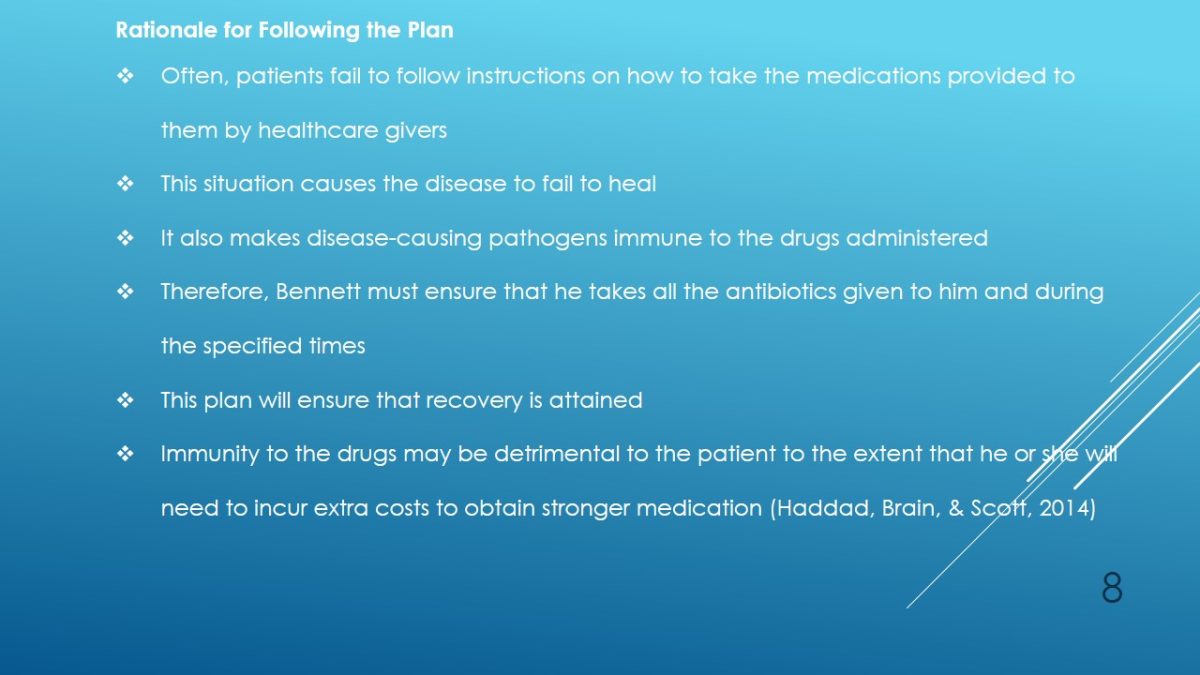
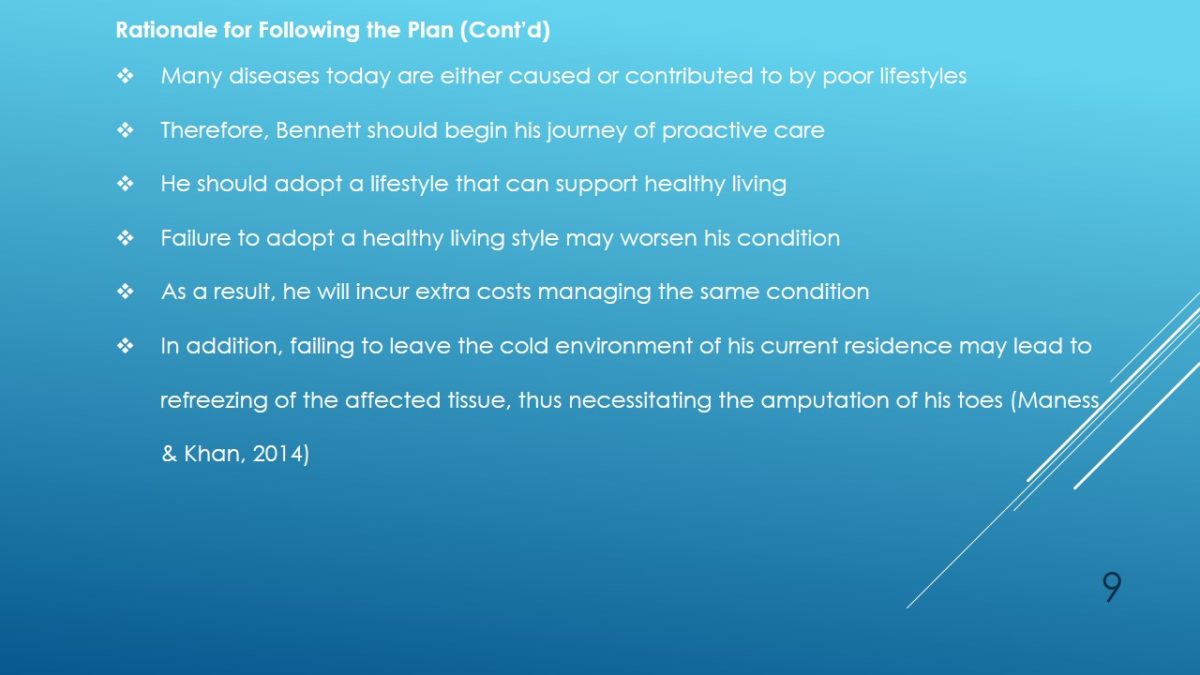
A Description of how Giving Client Education is Doing God’s Work
- The Bible encourages Christians to help others whenever they are able without expecting to be refunded.
- The rationale of this Bible teaching can be adopted in healthcare, especially relating to the treatment of patients with a low SES.
- Healthcare in the US is expensive, as situation that prevents many low-income people such as Bennett from accessing quality care.
- The fee-for-service approach to healthcare favors only patients who can afford to pay for care.
- Christian nurses can make efforts to minimize the disparity in healthcare that is caused by ensuring that the poorer patients also have access to comprehensive care (White, 2013).
- One way that caregivers can help low-income patients is through client education.
- Nurses interact with patients from different economic and ethnic backgrounds.
- Nurses who adopt Christian values in their profession are likely to be sensitive to these differences, hence rendering objective care to the patients (White, 2013).
- Christian nurses view their patients as brothers and sisters, as well as people who deserve quality care, regardless of their SES status.
- This belief is based on the Christian understanding that all people are equal before God.
- Christianity and organized healthcare can be traced back to the collapse of the Roman Empire.
- At the time, only patients who had money could access healthcare.
Client education helps patients to manage their condition with minimum assistance from healthcare attendants. As a result, their health is improved without having to incur unnecessarily high costs.
Christians who are trained in healthcare would step in and assist patients with low income based on the Christian teaching of helping those in need. These early values should be reflected in modern care among Christian nurses. The Nurses Christian Fellowship International (NCFI) calls for nurses to adopt the virtues of love, unity, respect, equity, and integrity in dealing with their patients (White, 2013).
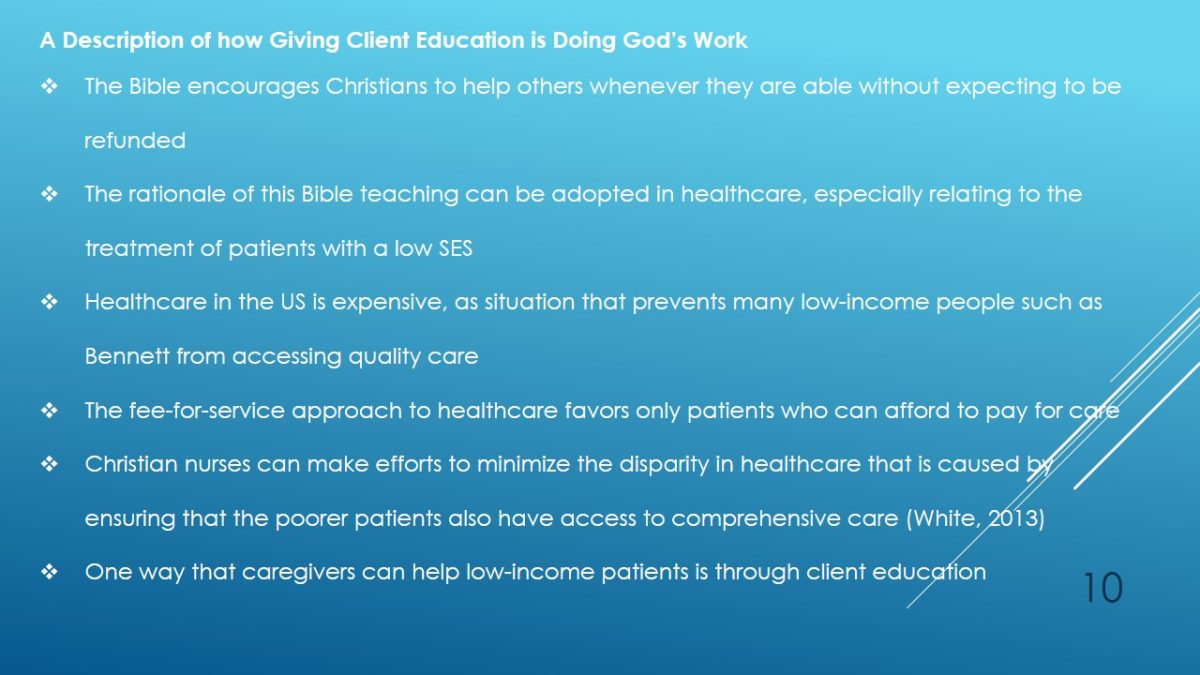

References
Acri, M. C., Bornheimer, L. A., O’Brien, K., Sezer, S., Little, V., Cleek, A. F., & McKay, M. M. (2016). A model of integrated health care in a poverty-impacted community in New York City: Importance of early detection and addressing potential barriers to intervention implementation. Social Work in Health Care, 55(4), 314-327.
Chambers, C., Chiu, S., Scott, A. N., Tolomiczenko, G., Redelmeier, D. A., Levinson, W., & Hwang, S. W. (2014). Factors associated with poor mental health status among homeless women with and without dependent children. Community Mental Health Journal, 50(5), 553-559.
Greene, J., & Hibbard, J. H. (2012). Why does patient activation matter? An examination of the relationships between patient activation and health-related outcomes. Journal of General Internal Medicine, 27(5), 520-526.
Haddad, P. M., Brain, C., & Scott, J. (2014). Nonadherence with antipsychotic medication in schizophrenia: challenges and management strategies. Patient Related Outcome Measures, 5(1), 43-62.
Maness, D. L., & Khan, M. (2014). Care of the homeless: an overview. American Family Physician, 89(8), 634-640.
Miewald, C., & McCann, E. (2014). Foodscapes and the geographies of poverty: Sustenance, strategy, and politics in an urban neighborhood. Antipode, 46(2), 537-556.
White, B. (2013). Nurses Christian fellowship international: Partners in care. Journal of Christian Nursing, 30(2), 97-99.
Woo, E. K., Lee, J. W., Hur, G. Y., Koh, J. H., Seo, D. K., Choi, J. K., & Jang, Y. C. (2013). Proposed treatment protocol for frostbite: a retrospective analysis of 17 cases based on a 3-year single-institution experience. Archives of Plastic Surgery, 40(5), 510-516.